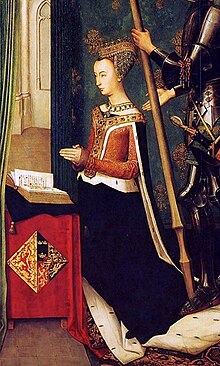Women in Medieval Scotland

Women in Medieval Scotland includes all aspects of the lives and status of women between the departure of the Romans from North Britain in the fifth century to the introduction of the Renaissance and Reformation in the early sixteenth century. Medieval Scotland was a patriarchal society, but how exactly patriarchy worked in practice is difficult to discern. A large proportion of the women for whom biographical details survive were members of the royal houses of Scotland. Some of these became important figures. There was only one reigning Scottish Queen in this period, the uncrowned and short-lived Margaret, Maid of Norway (r. 1286–90).
Some girls of noble families were taught in
In the
Status
Medieval Scotland was a
Royal women
A large proportion of the women for who biographical details survive for the Middle Ages, were members of the royal houses of Scotland, either as princesses or
Education

Girls of noble families were sometimes taught in nunneries such as
Marriage
By the late Medieval era, Lowland society was probably part of the north-west European marriage model, of life-cycle service and late marriage, usually in the mid-20s, delayed by the need to acquire the resources needed to be able to form a household.
Work

In Lowland rural society, as in England, many young people, both male and female, probably left home to become domestic and agricultural servants, as they can be seen doing in large numbers from the sixteenth century.[17] Some women would have been engaged as wet nurses to the children of noble and wealthy Lowland families and the important role of midwife was also reserved for women.[18] In the burghs there were probably high proportions of poor households headed by widows, who survived on casual earnings and the profits from selling foodstuffs or ale.[19] Spinning was an expected part of the daily work of Medieval townswomen of all social classes.[20] In crafts, women could sometimes be apprentices, but they could not join guilds in their own right. However, there are records of many widows continuing in their late husband's craft. Some women worked and traded independently, hiring and training employees, which may have made them attractive as marriage partners.[21]
Religion
Scotland had relatively few
See also
References
- ^ ISBN 0199563691, p. 273.
- ISBN 0199563691, p. 274.
- ISBN 0748621571, p. 175.
- ISBN 0748621571, pp. 170 and 174.
- ISBN 0415291828, p. 9.
- ISBN 1843832852, pp. 63–4.
- ISBN 1843832852, pp. 66–7.
- ISBN 0748621571, p. 126.
- ^ ISBN 1-84384-096-0, pp. 29–30.
- ISBN 1-4464-7-563-8, pp. 104–7.
- ISBN 1598849646, pp. 262–3.
- ISBN 1598849646, pp. 33–4.
- ISBN 0199563691, p. 277.
- ISBN 0748602763, pp. 29–35.
- ISBN 0199563691, p. 271.
- ISBN 0748614559, pp. 62–3.
- ISBN 0521891671, p. 52.
- ISBN 0748621571, pp. 6–10.
- ^ E. Ewen, "An Urban Community: The Crafts in Thirteenth Century Aberdeen" in A. Grant and K. J. Stringer, Medieval Scotland: Crown, Lordship and Community: Essays Presented to G.W.S Barrow (Edinburgh: Edinburgh University Press, 1998), p. 164.
- ^ E. Ewen, "An Urban Community: The Crafts in Thirteenth Century Aberdeen" in A. Grant and K. J. Stringer, Medieval Scotland: Crown, Lordship and Community: Essays Presented to G. W. S. Barrow (Edinburgh: Edinburgh University Press, 1998), p. 171.
- ISBN 1843835622, p. 110.
- ISBN 0521377978, p. 86.
- ISBN 074860104X, p. 80.
- ISBN 1843833867, pp. 124–141.
- ISBN 1843835207, pp. 178–14.
- ISBN 1843835622, p. 109.
- ISBN 1843835622, pp. 111–12.
- ISBN 0748620222, p. 11.
- ISBN 1843840960, pp. 26–9.
- ISBN 033363358X, p. 147.

